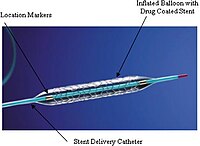
Photo from wikipedia
BackgroundThe new generation thinner-strut silicon carbide (SiC) coated cobalt chromium (CoCr) bare-metal stents (BMS) are designed to accelerate rapid endothelialisation and reduce thrombogenicity when implanted in coronary arteries. However, smaller… Click to show full abstract
BackgroundThe new generation thinner-strut silicon carbide (SiC) coated cobalt chromium (CoCr) bare-metal stents (BMS) are designed to accelerate rapid endothelialisation and reduce thrombogenicity when implanted in coronary arteries. However, smaller studies suggest higher rates of symptomatic restenosis in patients receiving the newer generation BMS.We investigated the efficacy of a newer generation ultrathin strut silicon-carbide coated cobalt-chromium (CoCr) BMS (SCC-BMS) as compared to an older thin-strut uncoated CoCr BMS (UC-BMS) in patients presenting with coronary artery disease requiring stenting of large vessels (≥3.0 mm).MethodsAll patients randomized to SCC- (n = 761) or UC-BMS (n = 765) in the two BASKET-PROVE trials were included. Design, patients, interventions and follow-up were similar between trials except differing regimens of dual antiplatelet therapy. The primary endpoint was clinically driven target-vessel revascularization within 24 months. Safety endpoints of cardiac death, non-fatal myocardial infarction (MI), and definite/probable stent thrombosis (ST) were also assessed. We used inverse probability weighted proportional hazards Cox regressions adjusting for known confounders.ResultsDemographics, clinical presentation, and risk factors were comparable between the groups, but patients receiving SCC-BMS underwent less complex procedures. The risk for clinically driven TVR was increased om the SCC-BMS group compared to the UC-BMS group (cumulative incidence, 10.6% vs. 8.4%; adjusted relative hazard [HR], 1.49 [95% CI, 1.05–2.10]). No differences in safety endpoints were detected, cardiac death (1.6% vs. 2.8%; HR, 0.62 [CI, 0.30–1.27]), non-fatal MI (3.2% vs. 2.5%; HR, 1.56 [CI, 0.83–2.91]), and definite/probable ST (0.8% vs. 1.1%; HR, 1.17 [CI, 0.39–3.50]). Differences in strut thickness between the two stents did not explain the association between stent type and clinically driven TVR.ConclusionsIn patients requiring stenting of large coronary arteries, use of the newer generation SCC-BMS was associated with a higher risk of clinically driven repeat revascularization compared to the UC-BMS with no signs of an offsetting safety benefit.
Journal Title: BMC Cardiovascular Disorders
Year Published: 2019
Link to full text (if available)
Share on Social Media: Sign Up to like & get
recommendations!